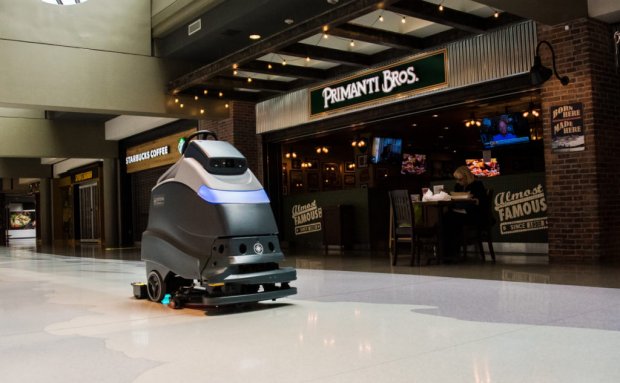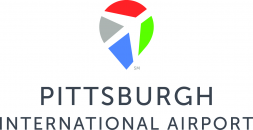PIT First U.S. Airport to Deploy Ultraviolet Cleaning – By Robots

PIT has teamed up with Pittsburgh-based Carnegie Robotics to deploy autonomous floor scrubbers that use UV technology designed to kill microbes in high-traffic areas. (Photo by Beth Hollerich)
At first glance, they look like your average industrial-strength floor scrubbers.
But these autonomous robotic cleaners are anything but ordinary. What makes them particularly special is the integration of ultraviolet lights that augment their traditional cleaning tools, a first for U.S. airports.
In response to the COVID-19 pandemic, airports and other public spaces are searching for ways to enhance their cleaning methods. Researchers believe UV-C rays, which have been used to sanitize hospital rooms for decades, can be applied in other high-traffic settings, like airports, with similar results.
PIT has teamed up with Pittsburgh-based Carnegie Robotics to deploy a pair of autonomous floor scrubbers — essentially self-driving robots that clean floors in an ultra-efficient manner.
The application of UV is part of a strategic airport-wide approach to cleaning as airport officials look to incorporate UV disinfecting technology in additional ways, including on handrails of escalators and moving walkways, elevator buttons and other high-touch areas, said Katherine Karolick, senior vice president of Information Technology for Pittsburgh International Airport.
As the aviation industry attempts to rebound from a dramatic downturn caused by the pandemic, restoring passenger confidence is key, she said.
“Passengers don’t just want to see a clean airport — they want to know it’s clean and they want to know it’s safe,” Karolick said. “Ultraviolet robots have been used in hospitals as a way to disinfect and kill microorganisms, so it is definitely something that makes sense for an airport.”
Make way for machines
The scrubbers themselves are modified versions of machines built by Danish firm Nilfisk. Carnegie Robotics designed and manufactured the artificial intelligence and robotic systems for them that can map an area and then clean it without human help.
Partnering with the airport to test and refine those systems was an easy choice, said Carnegie Robotics Chief Financial Officer Daniel Beaven.
“An airport, as a particular application space, is very representative of a lot of public spaces: high traffic, big open areas, reflective surfaces, a lot of safety concerns,” he said. “It’s a great challenge for us.
“Our No. 1 priority in this testing, however, is to understand how effective the addition of UVC is as a disinfectant in combination with Nilfisk’s scrubber.”
The scrubbers scour the floor surface with 88 pounds per square inch of water pressure. Chemical disinfectant can be added to the process for a deeper clean, and the UV rays then pass over, creating three different levels of cleaning for the surface.
Researchers will examine the floor surface after the UV scrubber passes over it to determine if any microorganisms remain.
The autonomous scrubbers are the only such third-party safety-certified machines in the world, a certification process approved by the American National Standards Institute that ensures safe operation in public spaces.
To instruct the robot, a worker drives the machine around the outside edge of an area and the onboard computer saves it to memory. Back at the starting point, the press of a button sends it on its way and the robot automatically cleans the entire area. Stereo cameras mounted on the front of the scrubbers detect obstacles — even people — and will stop the machine immediately if its path is impeded.
Once the scrubber is going, workers only need to change the water supply after about 150 minutes and recharge the battery after about six hours. They can then focus on other tasks.
Leo Agafonov, field testing manager for Carnegie Robotics, noted the machines can still be used manually when required.
More research to come
The partnership with homegrown Carnegie Robotics is the first step of an airport-wide strategy to deploy technology solutions and a multi-layered cleaning processes to enhance the health and safety of the traveling public. The UV technology is designed to kill microbes in high-traffic areas, increasing cleanliness and helping to restore confidence in traveling.
“Pittsburgh is a center for robotics and artificial intelligence,” Karolick said. “Any time we can tap into the talent of the region, it’s a win for us.”
The partnerships are part of airport leadership’s aggressive approach to finding technological solutions to improve the airport. Its X-Bridge lab features 10,000 square feet of space that includes a design studio, maker space and even an “X-Gate” where developments can be tested and refined at a boarding area.
“The health and safety of airport staff and the traveling public are always the top priorities,” said Pittsburgh International Airport CEO Christina Cassotis. “We know that restoring confidence in travel is going to be key to the industry recovery. That’s why we’re incorporating world-leading Pittsburgh technology as part of the solution.”


